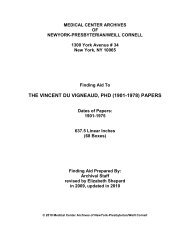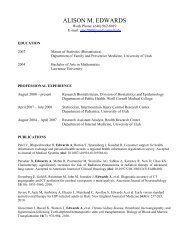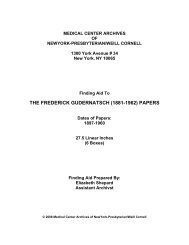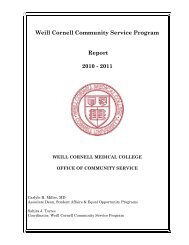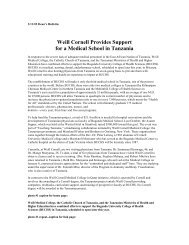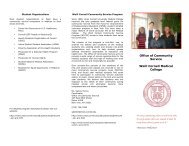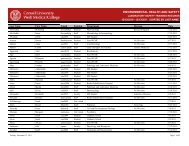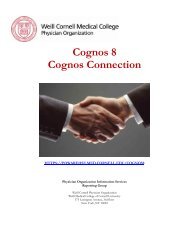Weillcornellmedicine - Weill Medical College - Cornell University
Weillcornellmedicine - Weill Medical College - Cornell University
Weillcornellmedicine - Weill Medical College - Cornell University
Create successful ePaper yourself
Turn your PDF publications into a flip-book with our unique Google optimized e-Paper software.
Funded by two consecutive five-year Program<br />
Project grants from the NIH’s National Institute on<br />
Drug Abuse, the team’s latest work has focused on<br />
the molecular and biochemical structures of drug<br />
targets called neurotransmitter-sodium symporters—specifically,<br />
how cells use them for neural<br />
signaling and where drug molecules bind to them.<br />
“These members of the transporter family are<br />
involved in everything that has to do with neuronal<br />
communication,” says Weinstein, the Upson<br />
Professor of Physiology and Biophysics and director<br />
of <strong>Weill</strong> <strong>Cornell</strong>’s Prince Alwaleed Bin Talal Bin<br />
Abdulaziz Alsaud Institute for Computational<br />
Biomedicine. “So the fundamental science explaining<br />
the mechanism was enormously compelling.”<br />
Key to understanding how the brain processes<br />
SSRIs was the discovery, made using computational<br />
simulation, of a second binding site for the<br />
neurotransmitter (near the opening of the molecule<br />
to the outside of the cell), which “turns on<br />
the engine” to move the neurotransmitter (serotonin,<br />
say) across the cell membrane. The fuel for<br />
this is a pair of sodium ions that use the transporter<br />
to penetrate into the cell as well, gravitating<br />
from an area of high sodium concentration<br />
—outside the cell—to low concentration inside<br />
the cell. This move releases the energy required to<br />
drive the neurotransmitter into the cell. The<br />
SSRIs, they found, block this cycle, preventing<br />
reuptake of serotonin and therefore keeping levels<br />
of the mood-enhancing neurotransmitter higher<br />
in the space between brain cells known as the<br />
synaptic cleft, where it keeps signaling. By more<br />
fully understanding this mechanism, Weinstein<br />
says, future drug designers may be able to spare<br />
SSRI users from common side effects like sleeplessness,<br />
sexual dysfunction, nausea, and anxiety. “If<br />
you know how it works, you can discover new<br />
ways to regulate it, new families of compounds<br />
that don’t have the side effects,” Weinstein says.<br />
“That is the hope.”<br />
The work has also opened a path to understanding<br />
how the brain processes amphetamines—among<br />
the next targets of the group’s<br />
research. “An amphetamine opens the transporter’s<br />
gate from inside the cell. It is usually<br />
closed and opens only when something comes in<br />
from the outside,” Weinstein explains. “But if<br />
you just open the gate, the neurotransmitter will<br />
do the same thing that sodium does—it will rush<br />
from where there is a lot of it, inside the cell, to<br />
where there is only a little of it, outside the cell.<br />
That’s why amphetamine gives you these ‘rushes.’<br />
While it is known to drive the neurotransmitter<br />
from inside the cell into the synaptic cleft,<br />
nobody knows how this works.” As with SSRIs, a<br />
fuller picture will allow for the design of medically<br />
acceptable amphetamines (currently used to<br />
treat conditions ranging from narcolepsy to<br />
attention-deficit disorder) that lack side effects<br />
such as increased risk of heart attack—and perhaps<br />
also point to new methods of curbing addiction<br />
to their illegal counterparts, such as crystal<br />
methamphetamine.<br />
Cocaine targets another member of this transporter<br />
family, the one that moves dopamine from<br />
the synaptic cleft back into the neural cell. “Ever<br />
since that became clear, there was an extraordinary<br />
push, strongly supported by the National<br />
Institute on Drug Abuse, to make a cocaine antagonist—ligands<br />
that would compete with cocaine,<br />
but not have the detrimental effects of cocaine,”<br />
Weinstein says. “Lots of money went into this,<br />
and a lot of attention.” But he and his colleagues<br />
found that, to their surprise, cocaine actually<br />
binds to the transporter protein itself, in the same<br />
location where the dopamine would normally<br />
bind. “That means that it will not be possible to<br />
find an inhibitor of cocaine that will bind in the<br />
same place as cocaine and not do what cocaine<br />
does,” Weinstein says. “So this has moved the<br />
entire study of cocaine antagonism into a completely<br />
new area. It has closed one direction and<br />
opened a new one.”<br />
With three years remaining on their second<br />
five-year grant from the drug abuse institute, the<br />
tri-campus group—which Weinstein says has<br />
achieved “a synergy that is quite extraordinary”—<br />
hopes to address how its most recent discovery fits<br />
into the larger biological picture. “All mechanisms<br />
in biology are regulated,” Weinstein says. “What<br />
we are interested in now is how this transport<br />
mechanism is regulated. Regulation is enormously<br />
important to understanding how the entire cell<br />
works and how disease affects that mechanism.”<br />
He compares their task to the sort of reverse-engineering<br />
that was done on captured Soviet aircraft<br />
during the Cold War, as parts were disassembled to<br />
determine the underlying technology. “What is<br />
important is to understand how the cell works as a<br />
system—as a whole, interrelated, intermeshed set<br />
of components,” Weinstein says. “What we call<br />
‘diseases’ are essentially impairments of the functions<br />
of cells, which are indeed due to flaws in the<br />
machinery but lead to a malfunction of the entire<br />
system. To fix the system, we need to understand<br />
how each piece of machinery serves it.”<br />
— Beth Saulnier<br />
Ties that bind: An illustration<br />
of the cycle in which sodium<br />
ions drive the transport of<br />
neurotransmitters<br />
WINTER 2008/09 13



